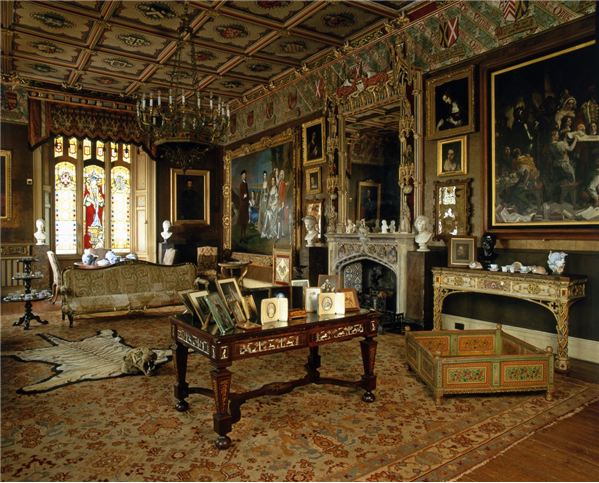Knebworth House in Hertfordshire is an early 16th century Tudor country house with dramatic 18th century Gothic additions [1]. It has been featured in a number of films, especially its impressive turreted exterior; the 1996 made-for-TV movie The Canterville Ghost made particularly good use of Knebworth's ornate rooms.
Although this house dates back to the 16th century, the collecting of art did not become a feature of country houses until the early 17th century [2]. There is an upsetting lack of information available about the art decorating the walls of Knebworth House, but each work doubtless has its own significance and history to the family.
The art in the state drawing room would have had an additional importance as well; as country houses regularly received visitors and tourists in the 18th and 19th centuries, certain rooms took on a more public function [3]. Art in these rooms, such as halls and drawing rooms, were meant for the owner's private enjoyment as well as public appreciation. The impressive group family portrait, visible below and in a scene of The Canterville Ghost, would have received much attention from visitors to the house as a fine example of a realistic treatment of faces merging with a picturesque quality of the background. And while non-family members could appreciate the artistic style of the portrait, it would carry further significance for the owner, as these would most certainly be depictions of relatives.
The Canterville Ghost- in the state drawing room
The Picture Gallery at Knebworth House serves as a kind of timeline of previous owners and family members. All of these portraits have been brought together and play a significant part in telling the story of the house and its development [4]. They are displayed in a long hall in a traditional manner- with an ornately decorated ceiling and facing windows to provide natural light.
The Canterville Ghost- tour of the Picture Gallery
A portrait of Sir Simon de Canterville, the titular ghost in the movie, is included in the family portrait gallery. This portrait is crucial to the plot, as it is the first contact of the main character, Ginny, with Sir Simon's likeness. He is initially described as a tyrant who killed his wife, but Ginny sees sadness and loneliness in his eyes, and this connection with his portrait leads her to help the ghost to move on. Although the portrait itself does not look very historically accurate (the pose is unusual, particularly for a man, and the cropping just below the knees is quite awkward), its role as a representation of the inner soul and true personality of an individual is very pertinent.
The Canterville Ghost- portrait of Sir Simon de Canterville, played by Patrick Stewart
The idea that portraiture can convey a deeper truth about someone, simply from a superficial representation of their physical features is one that is widespread and generally accepted [5]. How artists are able to cut straight to the soul of the person they are depicting is more of a mystery. Artistic representations at Knebworth House show not only this important facet of portraiture, but also the importance of portraits to country house visitors.
Bibliography:
[1] The National Heritage List for England. “Knebworth.”
Accessed April 11, 2013. http://list.english-
heritage.org.uk/resultsingle.aspx?uid=1000255.
[2] McBride, Kari
Boyd. Country House Discourse in Early
Modern England: a Cultural Study of Landscape and
Legitimacy. Aldershot, England: Ashgate, 2001.
[3] Hearn, Karen. In Celebration: the Art of the Country House.
London: Tate Gallery, 1998.
[4] Musson, Jeremy. How to Read a Country House. London:
Ebury Press, 2005.
[5] Badea-Päun,
Gabriel. The Society Portrait: from David
to Warhol. New York: Vendome Press, 2007.






also of note the house was vastly reduced in size in the early 19th century, it used to be an enormous four sided square with a central courtyard; roughly 1/3 of the house remains, largely the west wing.
ReplyDelete